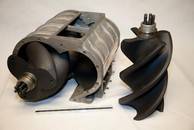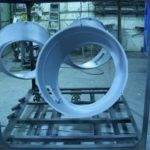PTFE coatings, colloquially referred to as Teflon® coatings, makes many modern products possible, thanks to the heat, chemical, water and electrical resistance this industrial coating provides. Proper pretreatment of materials before the application of this non-stick, low-friction coating is essential to getting the greatest benefit from PTFE coating.

Discovered in the 1930s, polytetrafluoroethylene has a vast number of applications. It is used in everything from boat propellers, to aerospace applications, to cookware. About half of all PTFE production is used to insulate wires for aerospace and computer applications. The coating serves as an excellent insulator against heat, electricity, and radio and microwave interference. Thanks to its low-friction properties, PTFE coating services are commonly used for bearings, gears, and other mechanical applications.
Over the years, industrial researchers have found that certain pre-treatments can improve a PTFE coating’s performance. These pre-treatments include:
Pre-Treating Materials
Getting the material to be coated ready for the PTFE coating service plays a key part in obtaining the best coating adhesion and durability from the industrial coating. Substrates must be cleaned and roughened prior to PTFE application to remove contaminants and allow the coating to more easily bond to the surface.
Zinc Phosphate Pretreatment
Zinc phosphate pretreatment is typically performed for substrates such as carbon steel. This chemical conversion treatment helps to keep the carbon steel from corroding. In zinc phosphate pretreatment, the process creates a thin layer of phosphate salts on the material’s surface.

This thin layer of phosphate salts chemically bonds to the material and helps the PTFE coating to better adhere to the surface. It also enhances corrosion resistance.
Zinc phosphate pretreatment is typically done by dipping or spraying the material. There are usually five steps to the process:
- Alkaline cleaning – an important cleaning process, as it kills biological contaminants
- Water rinsing
- Zinc phosphate application
- Second rinsing
- Chromate sealer application
During the zinc phosphate pretreatment process, temperature; dipping or spraying time; pH levels; solution strength; and rinse water quality must be carefully monitored.
Grit Blasting
Grit blasting prepares a surface for an industrial Teflon® coating by forcefully directing abrasive materials against it. This process both cleans and roughens the surface, making it more receptive to the PTFE coating. Grit blasting can be used on metallic and non-metallic surfaces.
Grit blasting helps to:
- Remove surface irregularities and roughen the surface to improve coating adhesion.
- Remove any existing coatings.
Grit blasting is a quick pre-treatment method, and the equipment needed is inexpensive, in most cases. In the grit blasting process, the substrate will be blasted with a sharp medium such as aluminum grit. Once the material has been grit blasted, it should undergo the industrial coating service as soon as possible to get the full benefit of the process and to avoid oxide layer growth that can result in a sub-standard coating job.
Product makers can determine how well the process worked by observing the evenness of the industrial coating and by measuring the surface roughness using a profilometer.
Hard Coating Anodizing
Hard coating anodizing is a chemical process used to pre-treat substrates for industrial Teflon® coatings. In this process, a film of aluminum oxide is created on the material to be coated. The process is typically done in an acid solution at low temperature that an electric current is passed through. The low temperature helps provide a harder, more corrosion resistant surface. Hard coat anodizing a surface prior to the PTFE coating service makes the substrate stronger, more resistant to corrosion, and smoother. Once a substrate has been hard coat anodized, applying a Teflon® coating will transfer the added benefits of Teflon® coating to the surface.
Hard coat anodizing has a number of applications in mechanical parts, household products, aerospace, automobiles, and much more.
After Pre-Treatment
When the coating is applied, it’s important to adhere to the dry film thickness recommendation. Industrial coatings that are too thick will cause problems such as mud cracking, blisters, or sagging. Coatings that are too thin will be evident from hazing or low gloss. Proper curing is also important to ensure that the coating and substrate bond well. In general, heating at about 750°F – 800°F for 10 minutes will properly cure most PTFE coatings.
If a PTFE coating or the pretreatment have not been successfully completed, products may have the following problems:
- Bubbles
- Pinholes
- Blisters
- Cobwebbing
- Dry Spray
- Eruptions in Die Cast Parts
- Fish Eyes
- Hazing
- Low Gloss
- Mud Cracking
- Orange Peel
- Overspray
- Cratering
- Particulate Contamination
- Peeling
- Flaking
- Sagging
Not every PTFE pre-treatment is appropriate to every product. Manufacturers should consult with the Orion technical consultants in the field of PTFE treatment before proceeding with selecting an industrial coating services. Orion technical consultants can advise on pre-treatment options as well as product types.
PTFE coatings are a time-tested and cost-effective coating, making them ideal for many products. With proper attention paid to the pretreatment of the substrate, PTFE coating can create an excellent surface that has the resistance to heat, electricity, chemicals, or water that your products require.
Questions? Contact us today.